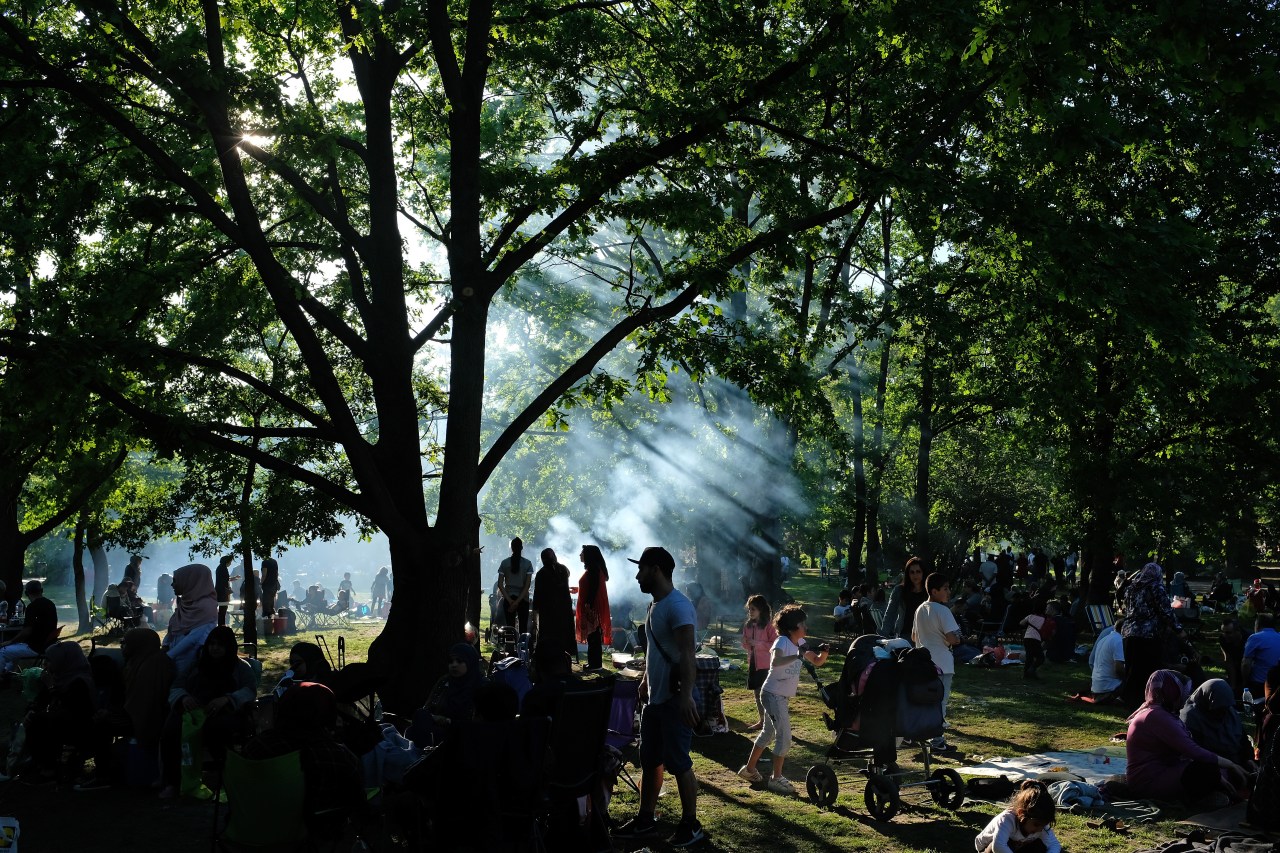Lamb skewers simmer over red-hot coals at Adana Grillhaus in Manteuffelstrasse, a busy street in the heart of Berlin’s hip, central Kreuzberg neighborhood. The chef manning the grill slices a few loaves of fluffy flatbread covered in sesame seeds rubs the insides with a piece of half-done lamb and throws the slices on the barbecue.
Like the owners of the späti (late-night corner store) next door and the owners of the grocery markets, kebab shops, teahouses, and convenience stores lining neighboring streets, Adana’s owners have Turkish roots. Ali Ayten has worked as a waiter at the restaurant for six years. “It was the first grill house like this to open in Europe—with a big open grill in the middle,” he says in German with a thick Berlin accent. Then he hurries off to serve glasses of ayran, a popular Turkish yogurt-based drink, to a group of young Germans.
Though the Berlin Wall came down in November 1989, evidence of how it divided the city is still visible, not least in its culinary landscape. Turkish grill houses, Vietnamese shopping malls selling delicacies from Asia, Mediterranean bistros opened by young people from southern Europe, and a slowly emerging local food scene all tell the story of the wall’s effects on the city’s appetites—both while it stood and after it fell.
Kreuzberg, which also goes by “Little Istanbul,” wasn’t a central neighborhood at all in the 1960s, when the first Turkish families came to work in factories as gastarbeiter (guest workers) after the postwar reconstruction period. Today Berlin is home to the largest number of people of Turkish descent outside Turkey: Around 177,000 people with Turkish passports or Turkish migration backgrounds live in the city; the country as a whole has around 4 million people with Turkish passports or roots.


In the 1960s Kreuzberg hugged the Berlin wall at the easternmost outskirts of West Berlin and was among the poorest and least central areas of the Western enclave. When the wall came down, Kreuzberg suddenly found itself in the middle of the reunited city, the gateway between the former East and West.
While the western side of where the wall stood has heavily Turkish roots, the other side, in the former East, is heavily populated by people with Vietnamese backgrounds. They own many spätis and imbisse (fast-food restaurants). The East needed guest workers just like the West did, but they turned to their government’s ally for labor. Around 60,000 Vietnamese were invited to Germany to work, and many stayed. According to German authorities, around 125,000 people living in the country hold a Vietnamese passport or have Vietnamese roots; of that number 20,000 live in Berlin.
“The presence of the wall is still here as a ghost,” says Joseph Pearson, a Berlin-based Canadian historian and author of the 2017 book Berlin. “There’s a clear distinction between the former West and East, in part because of the migrant groups that came to the two sides of the wall.”
Ethnic enclaves and their respective food traditions are not the only outgrowth of the wall. Pearson says the fact that food in Berlin—both international and German—is inexpensive has a lot to do with the wall.
“Berlin has had this fluctuation between being very open and attracting a lot of international people and then shutting down completely. That happened during the wars, of course, but also when the wall came up and made West Berlin an island in the sea of red and East Berlin off limits to many. Unless you were invited—for example as a guest worker—it was difficult to get in,” he says.

The shifts between open and closed have affected the culinary scene in two ways: The open periods introduced large groups of people from all over the world, bringing with them the foods and flavors of their homes. the closed periods, often marked by poverty, created a culture of cheap, fast food.
“For decades East Berlin had no culture of fine dining and no history of people spending money on food,” Pearson says.
Berlin’s quintessential snack, currywurst, reflects both these trends. German kiosk owner Herta Heuwer invented it in 1949 when Berlin was divided into four sectors: Soviet, American, British, and French. She combined German pork sausages with ketchup from the American sector and curry powder from the British. One of the most popular street snacks in Berlin, currywurst is served throughout the city at stalls such as Curry 36, and the dish even has its own museum.
Since the wall came down, young chefs from all over Europe, especially the south, have flocked to the city to open hip tapas bars, Italian osterias, and international street-food stalls. Only recently did the city experience a wave of hip German restaurants as well. Now Berlin-based chefs and restaurateurs are rebuilding the local-food culture in their city.

Billy Wagner considers it his call to arms. In 2015 the young sommelier, along with chef Micha Schäfer, opened Nobelhart & Schmutzig. The restaurant was awarded a Michelin star and quickly became what one Berlin food blog has called “the single most hyped restaurant of the decade in Berlin, and maybe also Germany.”
The restaurant’s approach to produce is brutally local: Since you can’t find pepper in the fields, forests, or lakes surrounding Berlin, you won’t find it in their kitchen, either. Every night they serve a set menu of 10 dishes based on hyperlocal ingredients, such as trout from lakes in Brandenburg and vegetables from farms outside the city; each dish is served to guests by the chef who prepared it. It’s a philosophy that would have been impossible to carry out decades earlier.
When the wall was up, West Berlin didn’t have access to local produce. It was an island in East Germany, and produce had to be shipped in from West Germany or abroad. East Berlin, on the other hand, had access to produce only from the rest of East Germany and the Soviet Union, and people there focused on mass production rather than quality.
“Every good cuisine in the world is affected by and in part based on the quality of the local produce that’s available. Imagine Paris and French cuisine without access to the area beyond the suburbs. It’s unthinkable,” Wagner says. “On top of that Berlin has never been a city with much industry or money, and nobody—not the producers, not the chefs, not the customers—thought much about what gastronomy meant.”
It took Wagner’s chefs some time to educate their vegetable, meat, fish, and poultry producers about the quality they required.


“They were surprised we didn’t care about how much more it would cost to produce a beetroot of higher quality,” he says.
Berlin’s local-food scene is finally growing. Producers are improving the quality of their produce as restaurants like Nobelhart & Schmutzig experiment with what contemporary Berlin cuisine might look like. The city’s established Michelin restaurants are focusing more on local produce, and young chefs are opening restaurants like Kumpel & Keule, Restaurant Einsunternull, Herz & Niere, Lokal, and PeterPaul—all intent on bringing hometown food back to a global city.
“The fall of the wall made a Berlin food scene possible, but everything started from scratch when [it] fell,” Wagner says. “We’re still at the beginning.”